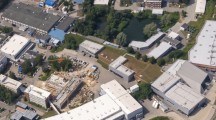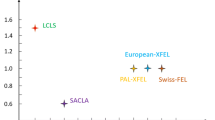Abstract
The European XFEL will be a free electron laser based on self amplified spontaneous emission in the X-ray regime. The FEL is driven by a superconducting 17.5 GeV linear accelerator, followed by 5 separate undulators both for SASE FEL radiation and incoherent radiation. Start of operation is foreseen for 2013. This paper presents the layout of the European XFEL, with an emphasis on beam dynamics issues.
Access this chapter
Tax calculation will be finalised at checkout
Purchases are for personal use only
Preview
Unable to display preview. Download preview PDF.
Similar content being viewed by others
REFERENCES
M. Altarelli et al. (eds.), The European X-Ray Free-Electron Laser Technical Design Report (DESY 2006-xxx, Hamburg, 2006).
S. Schreiber et al., The Injector of the VUV-FEL at DESY, Proceedings of FEL 2005, Palo Alto, 2005.
K. Abrahamyan et al., Experimental characterization and numerical simulations of the electron source at PITZ, Nucl. Instr. and Meth. A, Volume 558, Issue 1, 1 March 2006, Pages 249–252.
P. Piot et al., Conceptual design for the XFEL Photoinjector, DESY TESLA-FEL 01-03, 2001.
V. Balandin et al.: Optimized Bunch Compression System for the European XFEL. PAC 2005, Knoxville, 2005.
Ch. Gerth, M. Röhrs, H. Schlarb, Layout of the diagnostic section for the European XFEL, Proceedings of PAC 2005, Knoxville, 2005.
V. Ayvazyan, et al., First operation of a Free-Electron Laser generating GW power radiation at 32 nm wavelength, Eur. Phys. J. D37 (2006) 297.
M. Dohlus, T. Limberg, CSRtrack: Faster Calculation of 3D CSR effects, FEL 2004, Trieste, 2004.
E. Saldin, E. Schneidmiller, and M. Yurkov, Nucl. Instrum. Meth. A 528 (2004) 355.
G. Amatuni, V. Tsakanov, W. Decking, R Brinkmann, Single Bunch Emittance Preservation in the XFEl Linac, Proceedings of 37th ICFA Advanced Beam Dynamics Workshop on Future Light Sources, Hamburg, 2006.
N. Baboi, Multi-Bunch Beam Dynamics Studies for the European XFEL, Proceedings of LINAC 2004, Lübeck, 2004.
R. Brinkmann et al. (eds.), TESLA Technical Design Report–Part II: The Accelerator (DESY 2001-011, Hamburg, 200), http://tesla.desy.de.
Author information
Authors and Affiliations
Editor information
Editors and Affiliations
Rights and permissions
Copyright information
© 2007 Springer
About this paper
Cite this paper
Decking, W. (2007). THE EUROPEAN XFEL PROJECT. In: Tsakanov, V., Wiedemann, H. (eds) Brilliant Light in Life and Material Sciences. NATO Security through Science Series. Springer, Dordrecht. https://doi.org/10.1007/978-1-4020-5724-3_2
Download citation
DOI: https://doi.org/10.1007/978-1-4020-5724-3_2
Publisher Name: Springer, Dordrecht
Print ISBN: 978-1-4020-5722-9
Online ISBN: 978-1-4020-5724-3
eBook Packages: Physics and AstronomyPhysics and Astronomy (R0)




